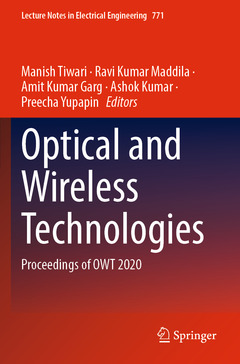Description
Optical and Wireless Technologies, 1st ed. 2022
Proceedings of OWT 2020
Lecture Notes in Electrical Engineering Series, Vol. 771
Coordinators: Tiwari Manish, Maddila Ravi Kumar, Garg Amit Kumar, Kumar Ashok, Yupapin Preecha
Language: English
Subjects for Optical and Wireless Technologies:
Publication date: 09-2022
593 p. · 15.5x23.5 cm · Paperback
Publication date: 09-2021
Support: Print on demand
Description
/li>Contents
/li>Biography
/li>Comment
/li>
This book comprises select proceedings of the 4th International Conference on Optical and Wireless Technologies (OWT 2020). The contents of this volume focus on research carried out in the areas of Optical Communication, Optoelectronics, Optics, Wireless Communication, Wireless Networks, Sensors, Mobile Communications and Antenna and Wave Propagation. The volume also explores the combined use of various optical and wireless technologies in next generation applications, and their latest developments in applications like photonics, high speed communication systems and networks, visible light communication, nanophotonics, wireless and MIMO systems. This book will serve as a useful reference to scientists, academicians, engineers and policy-makers interested in the field of optical and wireless technologies.
Dr. Manish Tiwari received Ph.D. in Electronics and Communications Engineering (ECE) in the field of Photonics from MNIT Jaipur, India. Presently, he is Professor in Department of ECE at Manipal University Jaipur. He has been visiting researcher to City University, London under UKIERI project in Microstructured Optical Fibers between 2010- 2011 and Tsinghua University, Beijing in 2016. Dr. Tiwari has presented talk in PolyU-Hong Kong, KMUT-Bangkok, Kasetsart University-Bangkok, City University- London and several UKIERI workshops. He has also served on panel of experts in various workshops by CSTT, MHRD, Government of India. His current research interest includes Micro/Nano-structure photonic devices, nonlinear optics and photonic crystal fibers.
Dr. Ravi Kumar Maddila did his Bachelors (Electronics and Communication Engineering) in 2000 from Utkal University, India. He obtained his Master’s (Opto Electronics and Laser Technology) in 2005 from International School of Photonics, Cochin University of Science & Technology, Kochi, India. His Ph.D. on Optical CDMA codes was awarded by the G. S. Sanyal School of Telecommunications, Indian Institute of Technology (IIT) Kharagpur, India. His research interests include optical communication, integrated optics, visible light communication and daylighting. He has published more than 40 articles in various journals and conferences and is a reviewer of several journals and conferences. His publications have been cited by more than 140 articles. He has guided two Ph.D. scholars, more than 15 M.Tech. theses and is currently supervising six Ph.D. scholars.
Dr. Amit Kumar Garg is an assistant professor in department of Electronics and Communications Engineering, Indian Institute of Information Technology, Kota, India. He obtained his Ph.D. from the Malaviya National Institute of Technology (MNIT), Jaipur, India in 2018. He received B.E. and M.Tech. in ECE from the University of Rajasthan and MNIT Jaipur in 2009




